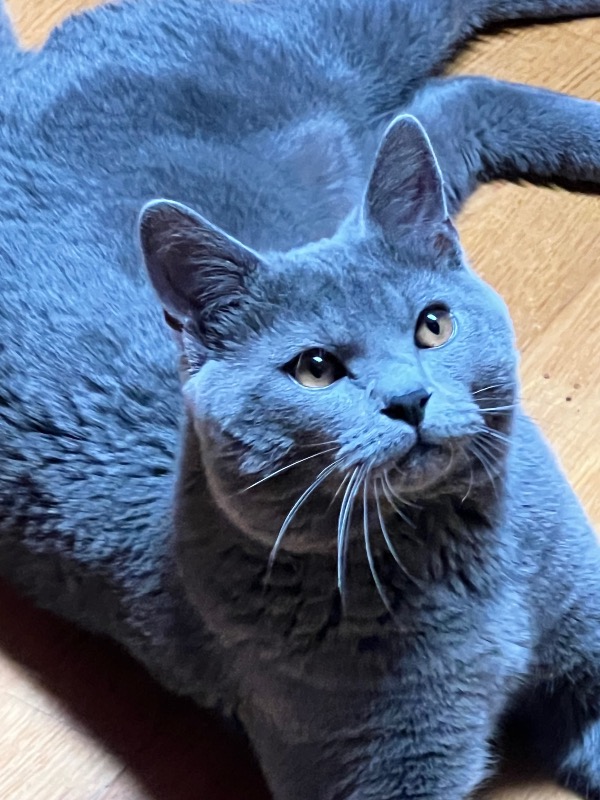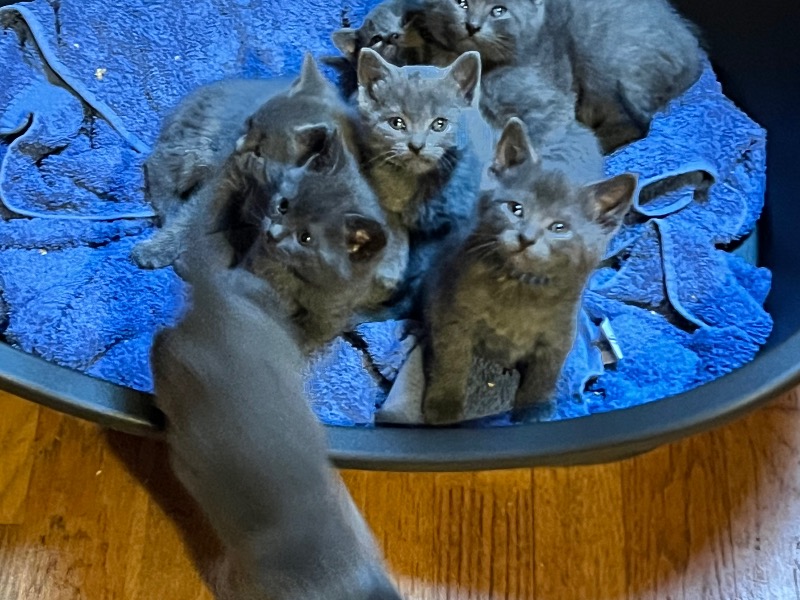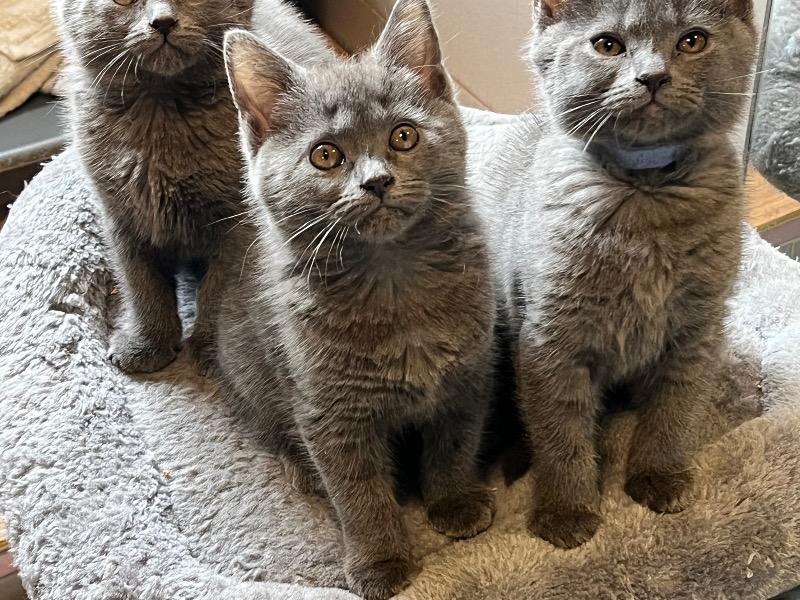Carthusian cat
Welcome to our page dedicated to the breed of cat carthusian cat!
Here, you will find all the useful information about carthusian cat. This descriptive profile will allow you to discover the aspects of this breed. You can notably consult information about the average price, monthly and annual upkeep expenses, their health, name ideas, as well as their official recognition by competent authorities.
Explore this page to discover everything you need to know.
Overall description of the breed
The Carthusian Cat is an ancient and iconic feline breed originating from France. Its history dates back centuries, and although its origins are shrouded in mystery and legends, it is known to be closely associated with the Chartreux region, from which it takes its name.
The ancestors of the Chartreux are wild cats from the Massif Central region in France, which were already present during the Middle Ages. They were domesticated by monks of the Carthusian Order, who lived in the remote monasteries of the region. These monks cared for these cats and bred them to hunt mice and other pests in the monasteries. The breed thrived thanks to the efforts of these dedicated monks, and its friendly nature and beauty have been appreciated from generation to generation.
Its morphology is robust and muscular, with an elegant and harmonious appearance. It is of medium to large size, with a slightly rounded head and full cheeks, giving it a gentle and expressive face. Its ears are medium-sized, slightly rounded at the tips, and its eyes are large, round, and luminous, typically copper or gold in color. The Chartreux is also known for its unique short, dense, and double coat, which feels almost woolly to the touch. Its fur is typically blue-gray in color, although shades ranging from light gray to dark gray are also observed.
In terms of character, the Chartreux is known for its affection, gentleness, and loyalty to its family. It is intelligent, calm, and well-balanced, making it an excellent companion for families and individuals. Despite its independent nature, it values the company of its humans and enjoys participating in family activities.
The average weight of the Chartreux ranges from 3.5 kg to 7 kg (8 to 15 pounds), with males typically larger than females. In terms of size, the Chartreux measures on average between 25 cm and 30 cm (10 to 12 inches) at the withers.
The founder club of the breed is the "Association Française du Chat des Chartreux" (AFCC). The breed standard was established in the 1930s, and in 1939, the Chartreux was officially recognized as a distinct feline breed by the Fédération Internationale Féline (FIFe). Since then, it is also recognized by other globally recognized feline organizations such as the Cat Fanciers' Association (CFA) in the USA and The International Cat Association (TICA).
The Carthusian Cat is a beloved cat breed worldwide, appreciated for its beauty, friendly character, and fascinating history. Despite its ancient origin, it continues to gain popularity and charm cat lovers due to its endearing personality and distinctive appearance.
Awareness of acquiring an animal
Each animal is a sensitive being, deserving love, attention and care.
When you choose to adopt an animal, you take on the responsibility of ensuring its health and well-being throughout its life.
To learn more about animal welfare, we invite you to consult our FAQ by clicking the button below:
Origins
The Chartreux is an ancient cat breed originating from France, known for its blue-gray coat and golden to copper eyes. According to legend, these cats lived with the Carthusian monks in French monasteries, hence their name. However, further research suggests that the Chartreux may have been introduced to Europe by crusaders returning from the Middle East, quickly adapting to the French climate and way of life.
History
The Chartreux has a long history in France, appreciated for its hunting skills and affectionate nature. The breed almost disappeared after the two world wars, but thanks to the dedicated efforts of French breeders, it was preserved and regained popularity. The Chartreux was officially recognized in Europe in the 1930s, and its presence has since expanded internationally.
Standard
The breed standard of the Chartreux emphasizes a muscular and robust body, with a broad chest and strong legs. Their head is round with full cheeks, giving a gentle expression, accentuated by large, round eyes ranging from golden yellow to copper. The coat is short, dense, and woolly, uniformly blue-gray in color. One of the breed's distinctive traits is its amiable smile, due to the structure of its head and its whiskers.
Physical characteristics
The Chartreux is known for its robust medium to large body, its short, dense, woolly coat of blue-gray color, and its expressive golden to copper eyes. Its broad head with a straight nose, small rounded ears set high, and characteristic sweet smile make it a cat of unique appearance. Despite its large size, it moves with grace and agility.
Character
Chartreux are calm, affectionate, and discreet. They are known for their attachment to their family, while remaining independent. These cats are less vocal than other breeds, often choosing to "speak" with a soft look or a slight headbutt. Their patient temperament and friendly nature make them excellent companions, even in the most active households.
Life expectancy
Chartreux cats are generally in good health, with a lifespan of 12 to 15 years, or even longer with proper care. They do not have genetic predispositions to specific diseases, but like all cats, they benefit from a balanced diet, regular veterinary care, and an active lifestyle to maintain their well-being.
Exercise and activity needs
Although the Chartreux may seem calm and reserved, it enjoys play sessions and activities that stimulate its mind and body. Interactive toys, food puzzles, and cat trees provide excellent opportunities for exercise and enrichment, helping to keep this sturdy breed in shape and happy.
Recommended diet
A high-quality diet, rich in proteins and low in carbohydrates, is best suited for the Chartreux, supporting its metabolism and activity level. Access to fresh water at all times is essential. The amount of food should be adjusted to its age, size, and activity level to avoid overweight.
Training and obedience
Chartreux, with their natural intelligence and desire to please, are relatively easy to train. They respond well to positive reinforcement and can learn simple commands, the use of the litter box, and scratching post. Starting training early and being consistent with the rules helps to develop good habits in the cat.
Behavior with children
The gentle and patient temperament of the Chartreux makes it an excellent companion for children. They are quite tolerant and can participate in games, provided they are not too rough. As with all interactions between animals and children, adult supervision is recommended to ensure everyone's safety.
Compatibility with Other Animals
The Chartreux, with its calm and non-dominant character, generally adapts well to life with other pets. Its tolerant and patient nature allows it to coexist peacefully with other cats and even dogs, provided they respect its space. Introductions must be done gradually to ensure a smooth acclimatization and prevent tension.
Grooming needs
The short but dense coat of the Chartreux requires relatively low maintenance. Weekly brushing is enough to remove dead hairs, reduce the formation of hairballs, and maintain the shine of its coat. It is rarely necessary to bathe a Chartreux, but regular maintenance of the ears and claws contributes to its good health and well-being.
Health
The Chartreux is renowned for its robustness and its lack of breed-specific health issues. However, like all cats, it can be prone to common illnesses such as dental diseases and obesity. Special attention to its diet and exercise, as well as regular veterinary visits, are crucial for maintaining its health throughout its life, which often spans 12 to 15 years, or even more.
Average price
The price of a Chartreux kitten can significantly vary depending on its lineage, sex, and whether the cat is intended for companionship, show, or breeding. On average, a Chartreux kitten costs between 800 and 1500 euros. It is important to deal with a reputable breeder who conducts health tests and offers post-adoption follow-up.
Expenses
Initial costs include the purchase price, vaccination, spaying or neutering, and basic accessories. Recurring expenses include quality food, preventive veterinary care, grooming, and the replacement of toys and accessories. Properly maintaining a Chartreux requires a monthly budget to ensure its well-being.
Name ideas
Inspired by its unique coat color and French origin, names such as Gris, Ciel (for its eyes), Pierre, Fantôme, or Bleu are popular. Elegant names like Monet, Hugo, or Dior can also reflect its noble demeanor. Its affectionate nature inspires names like Doux, Ami, or Câlin.
Legislation and regulation
No specific legislation governs the ownership of Chartreux cats in most countries. However, owners must comply with local regulations on pet ownership, which may include registration, vaccination, and spaying or neutering. It is also important to adhere to animal welfare laws.
Official recognition
The Chartreux is officially recognized by the main international feline associations, such as the Cat Fanciers' Association (CFA), the International Cat Association (TICA), and the Fédération Internationale Féline (FIFe). This recognition underscores its significance and popularity in the world of cat shows and ensures the maintenance of the breed's standards.
Pedigrees
Pedigrees, certifying the ancestry and the breed purity of the Chartreux, are available from certified breeders and feline associations. These documents are essential for those who wish to participate in cat shows or engage in breeding, as they provide proof of the breed's authenticity and its genetic qualities.
Destination and usage
Traditionally, the Chartreux was valued for its hunting skills. Today, it is primarily bred as a pet, appreciated for its gentle nature and its ease of adapting to family life. It can also participate in cat shows and selective breeding programs, thanks to its distinctive character and popularity.
Prohibitions
There are no specific bans on owning Chartreux cats. However, future owners must check local pet regulations to ensure they meet all care and habitation requirements.
Breeders of Carthusian cat
Want to see more breeders of Carthusian cat?
Check out the page of our directory listing all breeders of Carthusian catClassified Ads of Carthusian cat
Breed clubs of carthusian cat
No of carthusian cat breed clubs are currently registered on Preeders.
If you would like to highlight your breed club, sign up for free now and be the first to appear on this page.





